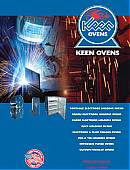Industrial Ovens
Front-Loading
![]() Under 10 cubic feet
Under 10 cubic feet
![]() 10-20 cubic feet
10-20 cubic feet
![]() Over 20 cubic feet
Over 20 cubic feet
![]() See All
See All
Top-Loading
![]() Under 10 cubic feet
Under 10 cubic feet
![]() 10-20 cubic feet
10-20 cubic feet
![]() Over 20 cubic feet
Over 20 cubic feet
![]() See All
See All
Learn About Our Industrial Ovens
Welding Ovens
![]() CONEX Storage
CONEX Storage
![]() Stick Electrodes
Stick Electrodes
![]() Sub-Arc Flux
Sub-Arc Flux
![]() Wire Spools
Wire Spools
![]() Tig Filler Wire
Tig Filler Wire
![]() Multi-Purpose
Multi-Purpose
![]() Nitrogen Purge
Nitrogen Purge
![]() See All
See All
 Order Our Free Catalog Today Click Here |
| Available Inventory |
Submerged Arc WeldingSubmerged arc welding is a common welding process that is often used in industries such as structural and vessel construction. Also known as Sub-Arc or SAW, this process uses a blanket of granular fusible flux, beneath which both the weld and the arc zone are protected or “submerged.” This flux blanket guards against atmospheric contamination, stabilizes the arc during welding, prevents splatter and sparks from flying about, and suppresses radiation and fumes that are typical of the shielded metal arc welding process. Click here to view our welding ovens Throughout the submerged arc welding process, the flux has to be a continuously-fed tubular or consumable solid electrode. This fusible flux may consist of lime, silica, manganese oxide, calcium fluoride, and other compounds. In a molten or melted state, the flux becomes conductive. This allows it to supply a constant current between the electrode and the welding work. The SAW process is usually automated; however, there are semi-automated systems available, too. Material applications of SAW include carbon steels, low alloy steels, stainless steels, nickel-based alloys, and surfacing applications (wear-facing, buildup, and corrosion-resistant overlay of steels). SAW is frequently used in heavy structural construction. It is also used in the pressure vessel industry, chemical plants, and shipbuilding. Properly performed Sub-Arc welding should consistently result in mechanical properties that are at least equal to that of the base metal. Ductility and impact resistance should be good, and bead appearance should be uniform. Advantages of Submerged Arc WeldingSome of the advantages of submerged arc welding include:
Disadvantages of Submerged Arc WeldingThere are a few limitations with submerged arc welding. One issue is that welding can normally be performed only in the flat position. The use of a granular flux and the fluidity of the molten weld pool mean that welding is limited to positions 1F, 1G, and 2F. Another disadvantage of SAW is that welding is normally limited to long, straight seams or rotated vessels or pipes. Flux handling systems can be quite bothersome, as well. Also See Variations of Submerged Arc Welding The Submerged Arc Welding (SAW) Process
|